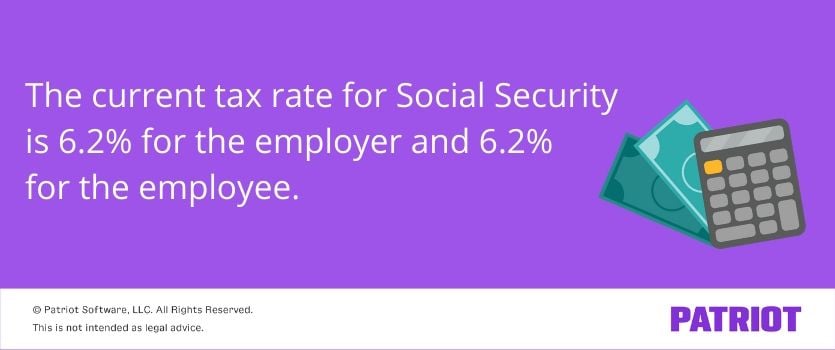As an employer, you’re responsible for keeping up with the latest tax news and withholding the correct amount of taxes from employee wages. One tax that you constantly need to keep up with is Social Security tax.
So, how often does Social Security tax increase? Read on to learn how frequently the Social security tax rate and wage base change.
Overview of Social Security tax
Social Security tax, or Old-Age, Survivors, and Disability Insurance (OASDI), is a payroll tax that both employees and employers must contribute to. Employers are responsible for withholding Social Security tax from employee wages.
Social Security taxes are used by the federal government to help support retired individuals, widows/widowers, and people with disabilities.
Social Security is one part of FICA tax. FICA tax is 15.3% and includes both Social Security (12.4%) and Medicare taxes (2.9%).
Social Security tax is a flat rate of 12.4%. Employees and employers must both contribute 6.2% for Social Security tax, which is based on the employee’s wages. You must withhold 6.2% from employee wages. Plus, you need to contribute 6.2% for the matching employer contribution.
Only a certain amount of employee wages are subject to Social Security tax. The threshold for the tax is referred to as the Social Security wage base. The Social Security wage base for 2022 is $147,000. This means you will stop withholding and contributing Social Security tax for an employee once they hit $147,000 in wages in the calendar year.
Both the Social Security tax rate and the wage base can change from year to year. In the last couple of decades, the rate has remained the same. However, the Social Security wage base tends to change from year to year.

Calculating Social Security tax
Before we dive deeper into how often Social Security tax increases, let’s look at a quick example of calculating Social Security tax using the current rate (6.2% for employees and employers).
To calculate Social Security tax, multiply the employee’s wages by the Social Security tax rate.
Say you pay an employee $2,000 weekly. Multiply $2,000 by 6.2% to determine how much to withhold from your employee’s wages.
$2,000 X 6.2% = $124
Withhold $124 from the employee’s wages for Social Security tax. And, contribute $124 for the employer portion.
Social Security tax increase
How frequently does the Social Security rate increase? In the past, the rate increased every few years. For example, from 1963-1965, the rate stayed the same. But in 1966, 1967, and 1968, the rate changed annually.
There is no specific “frequency” for how often the Social Security rate increases. Since 1990, the rate has (for the most part) remained at 6.2% for employees and employers (12.4% total). However in 2011 and 2012, the employee portion decreased from 6.2% to 4.2% due to the 2010 Tax Relief Act. From 2011-2012, the employer portion stayed at 6.2%.
Aside from the decrease in 2011 and 2012 for the employee portion, Social Security has never decreased.
Each time the Social Security rate increases, employers must increase Social Security withholding.
Social Security tax through the years: Chart
Want to find out how Social Security tax has changed over time? Check out our chart below to see Social Security tax rates through the years.
| Year | Social Security Rate for Employees and Employers | Total SS Rate |
|---|---|---|
| 1937-1949 | 1% | 2% |
| 1950-1953 | 1.5% | 3% |
| 1954-1956 | 2% | 4% |
| 1957-1958 | 2.25% | 4.5% |
| 1959 | 2.5% | 5% |
| 1960-1961 | 3% | 6% |
| 1962 | 3.125% | 6.25% |
| 1963-1965 | 3.625% | 7.25% |
| 1966 | 3.85% | 7.7% |
| 1967 | 3.9% | 7.8% |
| 1968 | 3.8% | 7.6% |
| 1969-1970 | 4.2% | 8.4% |
| 1971-1972 | 4.6% | 9.2% |
| 1973 | 4.85% | 9.7% |
| 1974-1977 | 4.95% | 9.9% |
| 1978 | 5.05% | 10.1% |
| 1979-1980 | 5.08% | 10.16% |
| 1981 | 5.35% | 10.7% |
| 1982-1983 | 5.4% | 10.8% |
| 1984-1987 | 5.7% | 11.4% |
| 1988-1989 | 6.06% | 12.12% |
| 1990-2010 | 6.2% | 12.4% |
| 2011-2012 | Employees 4.2% Employers 6.2% |
10.4% |
| 2013-current | 6.2% | 12.4% |
Social Security wage base increase
The Social Security wage base typically fluctuates from year to year. In most cases, the wage base increases. But sometimes, the wage base remains the same. For example, from 2009 to 2011, the Social Security wage base stayed at $106,800.
The wage base typically increases every year to accommodate the cost of living.
As an employer, you should anticipate Social Security wage base changes each year. And, you should prepare your payroll for changes.
Check out how the wage base has changed from year to year below:
| Year | Social Security Wage Base Amount |
|---|---|
| 1937-1950 | $3,000 |
| 1951-1954 | $3,600 |
| 1955-1958 | $4,200 |
| 1959-1965 | $4,800 |
| 1966-1967 | $6,600 |
| 1968-1971 | $7,800 |
| 1972 | $9,000 |
| 1973 | $10,800 |
| 1974 | $13,200 |
| 1975 | $14,100 |
| 1976 | $15,300 |
| 1977 | $16,500 |
| 1978 | $17,700 |
| 1979 | $22,900 |
| 1980 | $25,900 |
| 1981 | $29,700 |
| 1982 | $32,400 |
| 1983 | $35,700 |
| 1984 | $37,800 |
| 1985 | $39,600 |
| 1986 | $42,000 |
| 1987 | $43,800 |
| 1988 | $45,000 |
| 1989 | $48,000 |
| 1990 | $51,300 |
| 1991 | $53,400 |
| 1992 | $55,500 |
| 1993 | $57,600 |
| 1994 | $60,600 |
| 1995 | $61,200 |
| 1996 | $62,700 |
| 1997 | $65,400 |
| 1998 | $68,400 |
| 1999 | $72,600 |
| 2000 | $76,200 |
| 2001 | $80,400 |
| 2002 | $84,900 |
| 2003 | $87,000 |
| 2004 | $87,900 |
| 2005 | $90,000 |
| 2006 | $94,200 |
| 2007 | $97,500 |
| 2008 | $102,000 |
| 2009 | $106,800 |
| 2010 | $106,800 |
| 2011 | $106,800 |
| 2012 | $110,100 |
| 2013 | $113,700 |
| 2014 | $117,000 |
| 2015 | $118,500 |
| 2016 | $118,500 |
| 2017 | $127,200 |
| 2018 | $128,400 |
| 2019 | $132,900 |
| 2020 | $137,700 |
| 2021 | $142,800 |
| 2022 | $147,000 |
Tired of tracking Social Security tax changes? Patriot’s payroll software computes your payroll taxes, including your taxable wage base for employee and employer taxes so you don’t have to. Try our award-winning software for free today!
This article has been updated from its original publication date of March 4, 2020.
This is not intended as legal advice; for more information, please click here.



